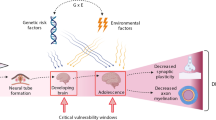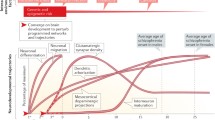Abstract
The hypothesis of a neurodevelopmental dysfunction being involved in the etiology of schizophrenia is suggested by the observation of morphological alterations in the brains of schizophrenia patients. These alterations may be caused by defects in neural cell differentiation or migration, which could lead to disrupted neuronal circuitry and to the schizophrenia symptomatology. The neural cell adhesion molecule (NCAM) plays a major role in cell migration and axon outgrowth, and is involved in synaptic plasticity mechanisms implicated in adult cognitive functions. Altered levels of the NCAM polysialylated form, PSA-NCAM, in the brain of schizophrenia patients have been reported, and are supportive of a role for this molecule in the disorder. To investigate the possible involvement of the NCAM gene in schizophrenia, we conducted a comprehensive genetic study, which included linkage analysis and an association study employing the Haplotype Relative Risk (HRR) design in nuclear families. Our results indicate that structural alterations in the NCAM gene are unlikely to play a major role in schizophrenia, although a function for the NCAM molecule in the etiology of the disease remains an intriguing hypothesis.
Similar content being viewed by others
Author information
Authors and Affiliations
Rights and permissions
About this article
Cite this article
Vicente, A., Macciardi, F., Verga, M. et al. NCAM and schizophrenia: genetic studies. Mol Psychiatry 2, 65–69 (1997). https://doi.org/10.1038/sj.mp.4000235
Received:
Revised:
Accepted:
Issue Date:
DOI: https://doi.org/10.1038/sj.mp.4000235
- Springer Nature Limited
Keywords
This article is cited by
-
Abnormal ER quality control of neural GPI-anchored proteins via dysfunction in ER export processing in the frontal cortex of elderly subjects with schizophrenia
Translational Psychiatry (2019)
-
Gene discovery through imaging genetics: identification of two novel genes associated with schizophrenia
Molecular Psychiatry (2009)
-
Polysialic acid in the plasticity of the developing and adult vertebrate nervous system
Nature Reviews Neuroscience (2008)
-
An association between a missense polymorphism in the close homologue of L1 (CHL1, CALL) gene and schizophrenia
Molecular Psychiatry (2002)




